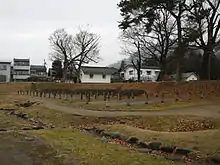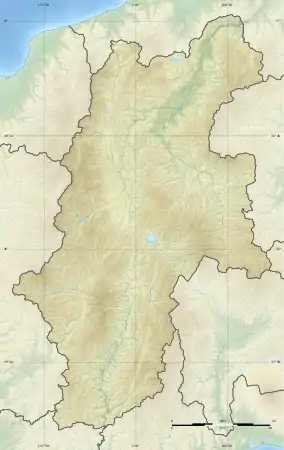Takanashi clan fortified residence
Takanashi clan residence ruins (高梨氏館跡, Takanashi-shi yakata ato) is an archaeological site containing the ruins of the Kamakura to early Sengoku period fortified residence of the Takanashi clan, local warlords in northern Shinano Province during that period. The site is located in what is now part of the city of Nakano, Nagano in the Chūbu region of Japan. The site was designated a National Historic Site of Japan in 2007.[1]
高梨氏館跡 | |
 Takanashi clan residence ruins | |
 Takanashi clan residence ruins  Takanashi clan fortified residence (Japan) | |
| Location | Nakano, Nagano, Japan |
|---|---|
| Region | Chūbu region |
| Coordinates | 36°44′41″N 138°22′36″E |
| Type | settlement |
| History | |
| Periods | Kamakura - Sengoku period |
| Site notes | |
| Ownership | National Historic Site |
| Public access | Yes |
Overview
The Takanashi clan was a cadet house of the Minamoto clan which gradually came to dominate northern Shinano Province during the Muromachi period. They were attacked by the Takeda clan from Kai Province and turned to the powerful Uesugi clan of Echigo Province for assistance. The Takanashi were allies of Uesugi Kenshin against Takeda Shingen at the Battle of Kawanakajima. However, with the rise of Oda Nobunaga the Takanashi gradually lost their territory and became retainers of the Uesugi. When Uesugi Kagekatsu was relocated from Echigo Province by Toyotomi Hideyoshi, the Takanashi clan followed him to Aizu and eventually to Yonezawa.
The ruins of their former clan residence in Shinano occupies a rectangular site measuring roughly 130 meters east-west by 100 meters north-south, surrounded by a moat and a palisade. The moat had a width of 10 meters and depth of three meters with a V-shaped cross-section. Within this enclosed area, an excavation survey conducted from 1986 to 1994, discovered the foundation pillars for twelve buildings, a well, and Shinto shrine. The remains of a Japanese garden was also discovered. The garden measured eight meters east-west by six meters north-south and contained a pond with three groups of rocks and river stones. It is the only Sengoku period garden to have been discovered in Nagano Prefecture.
The site is now a public park and is located approximately 10 meters on foot from Shinshū-Nakano Station
References
- "高梨氏館跡" (in Japanese). Agency for Cultural Affairs.
External links
- Nagano city official site (in Japanese)
- Nagano prefecture tourist information {ja}}